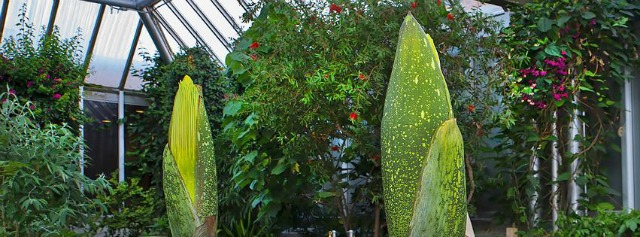Twin Corpse Flowers Are Poised To (Doubly) Stink Up Chicago Botanic Garden
By Stephen Gossett in Arts & Entertainment on May 23, 2017 7:22PM

Chicago Botanic Garden
If the stinky stars align, brave Chicagoans could soon have the chance to inhale the putrid, smelly "delights" that one can only find from the infamous corpse flower. Actually, make that two corpse flowers.
Something of a botanical rockstar thanks to its overwhelming pungency when in bloom, corpse flowers, also known as titan arums (Amorphophallus titanum), attract legions of olfactorily courageous fans when they finally open up and let the bad stench out. (Perhaps the best approximation of its smell comes from How Stuff Works, which describes it as a "combination of spoiled eggs, dirty laundry and day-old roadkill.")
Chicagoland corpse-flower groupies may have the chance to double their pleasure/pain: the Chicago Botanic Garden recently moved twin plants Java and Sumatra on public view to the Semitropical Greenhouse in anticipation of a bloom.
Java and Sumatra are the 4th and 5th #TitanArums to go on bloom watch at the Garden. https://t.co/PmF9ApW5jt #CBGTitanTwins #CorpseFlower pic.twitter.com/Kanz8AtwDS
— ChicagoBotanicGarden (@chicagobotanic) May 23, 2017
The pair comes from impressive stink stock, with both having the same parent plant as Sprout, which spread its anti-pheromones last April. (Alice bloomed the year prior at CBG; and most recently, Persephone attracted visitors with its repulsive ways last June, at Garfield Park Conservatory.
Of course, there's no guarantee that the pair will bloom together—or even at all. Spike, the Garden's first foray into corpse-flower-palooza, never lived up to the hype and disappointed its public by failing to blossom, in 2015. And despite the above-mentioned string of recent successes, a bloom is no sure thing, as the plants require vigilant cultivation in order to do so.
Corpse flowers tend to stay in bloom between 24 and 36 hours, but the peak window is even shorter; so we recommend putrid-loving pilgrims keep a close eye (nose?) out. Luckily, the Garden has you covered: you can follow their social media (and the #CBGTitanTwins hashtag); sign up for a bloom e-alert; or track the twins' growth live by tuning in to the Garden's round-the-clock feed below. (Check out pre-bloom clues here.) You can also track their towering rise (often 6 to 8 feet) on the site's growth chart.
[H/T DNAinfo]